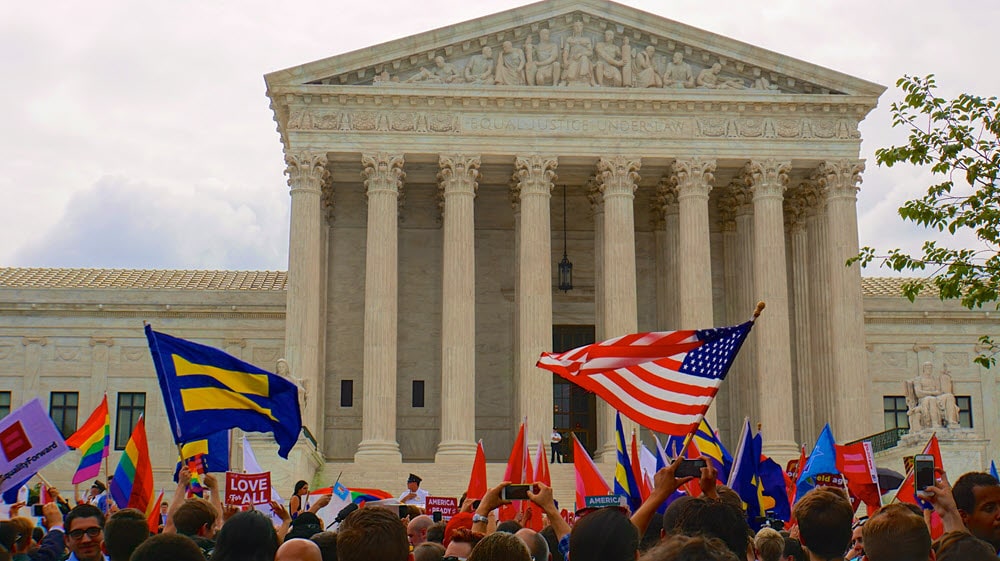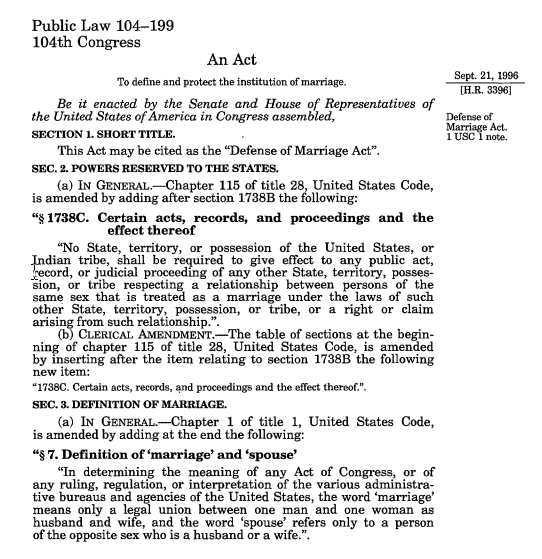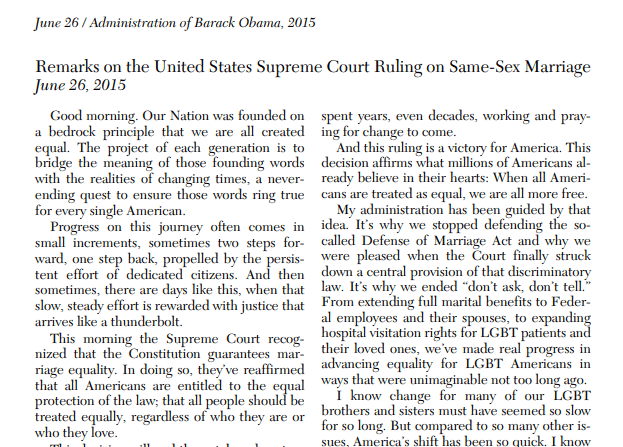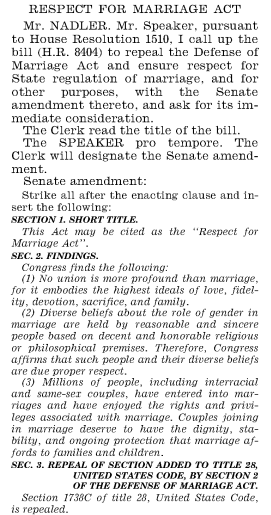The legal right to marry is something that heterosexual couples may take for granted, but for the LGBTQ+ community, the fight for same-sex marriages to be legalized and federally recognized took decades of activism, protest, and court cases. On June 26, 2015, in a 5-4 decision, the Supreme Court ruled that same-sex couples have the right to marry and gain federal marriage benefits in all U.S. states and territories. The case was Obergefell v. Hodges.[1]Obergefell et al. v. Hodges, Director, Ohio Department of Health, 576 U.S. Prelim. Print 644 (2015). This case can be found in HeinOnline’s U.S. Supreme Court Library. Let’s use HeinOnline to explore the history that led up to this monumental case that changed the trajectory of LGBTQ+ rights in America.

(“SCOTUS Marriage Equality 2015 (Obergefell v. Hodges) – 26 June 2015” by Ted Eytan, licensed under CC BY-SA 2.0)
Baker v. Nelson
Although the fight for LGBTQ+ rights had already been ongoing for decades, the movement began to ramp up in the 1960s with the Stonewall Riots. One year after the riots, in 1970, a same-sex couple, Richard Baker and James McConnell, attempted to apply for a marriage license in Minnesota but were rejected. The trial court upheld the rejection, as did the state’s supreme court when the couple tried to appeal. The case, Baker v. Nelson,[2]Baker v. Nelson, 191 N.W.2d 185, 187 (Minn. 1971). This case can be found in Fastcase. went to the Supreme Court when the couple appealed again, but the Court declined to hear the case. This set the precedent that federal courts would not rule on same-sex marriage, and that the decision would be left to individual states.
A few years later, in 1973, Maryland became the first state to pass a law that explicitly stated that marriage could only be between a man and a woman.[3]Maryland – General Assembly, Regular Session 574 (1973). This law can be found in HeinOnline’s Session Laws Library. Several other states subsequently followed suit.

The Defense of Marriage Act (DOMA)
In 1996, then-President Clinton passed the Defense of Marriage Act.[4]To define and protect the institution of marriage., Public Law 104-199, 104 Congress. 110 Stat. 2419 (1996). This act can be found in HeinOnline’s U.S. Statutes at Large database. While it didn’t outright ban gay marriage, Section 3 of this act did state that only opposite-sex couples would be eligible to receive federal marriage benefits, such as social security survivors’ benefits and filing joint tax returns. However, despite this law, in 2000 Vermont became the first state to fully legalize civil unions, while in 2003, Massachusetts became the first state to legalize gay marriage.

Additionally, the U.S. Senate in 2004 blocked a proposed constitutional amendment[5]9 (June 30, 2004) Same-Sex Marriages: Legal Issues. This document can be found in HeinOnline’s U.S. Congressional Documents database. that was supported by then-President Bush that would have outlawed same-sex marriage across America.
Throughout the 2000s, several states would pass their own constitutional amendments that either banned or legalized gay marriage. But in 2013, in the case United States v. Windsor,[6]United States v. Windsor, Executor of the Estate of Spyer, et al., 570 U.S. Prelim. Print 744 (2013). This case can be found in HeinOnline’s U.S. Supreme Court Library. the Supreme Court ruled that Section 3 of the Defense of Marriage Act was unconstitutional due to the equal protection clause under the 14th Amendment.[7]Amendatory treaty to the treaty of June 9, 1863, between the United States of America and the Nez Perce Tribe of Indians, . 15 Stat. 693 (1868). This act can be found in HeinOnline’s U.S. Statutes at Large database.
The Plaintiffs Behind Obergefell v. Hodges
Obergefell v. Hodges[8]Obergefell et al. v. Hodges, Director, Ohio Department of Health, 576 U.S. Prelim. Print 644 (2015). This case can be found in HeinOnline’s U.S. Supreme Court Library. represented six different lower-court cases that included 16 same-sex couples, seven children, a widower, an adoption agency, and a funeral director. These cases were filed between January 2012 and February 2014 and came from Michigan, Ohio, Kentucky, and Tennessee.
Michigan: DeBoer v. Snyder
April DeBoer and Jayne Rowse had held a commitment ceremony in February of 2007. They had adopted children, but according to Michigan law, only single people or married couples could legally adopt. In the case DeBoer v. Snyder,[9]DeBoer v. Snyder, 772 F.3d 388, 409 (6th Cir. 2014). This case can be found in Fastcase. the couple claimed that Michigan’s adoption law was unconstitutional.
Ohio: Obergefell v. Kasich and Henry v. Wymyslo
Obergefell v. Kasich[10]Obergefell v. Kasich, 1:13-cv-501 (United States District Court Southern Distrcit of Ohio Western Division 2013). This case can be found in Fastcase. involved two different same-sex couples, James Obergefell and John Arthur, and David Michener and William Herbert Ives. Obergefell and Arthur had gotten married in Maryland, but their state of residence, Ohio, did not recognize their marriage. Arthur died shortly after their marriage. Michener and Ives had been married in Delaware, but Ives died in Ohio. Both couples fought to have the surviving spouse listed on a death certificate.
Meanwhile, Henry v. Wymyslo involved four couples, Georgia and Pamela Yorksmith, Kelly Noe and Kelly McCracken, Joseph Vitale and Robert Talmas, and Brittany Henry and Brittni Rogers were all married in states where same-sex marriage was legal. Each couple had adopted children, and they all filed a lawsuit to force Ohio to list both parents on their children’s birth certificate. The adoption agency also sued in this case.
Kentucky: Bourke v. Beshear and Love v. Beshear
Bourke v. Beshear[11]Bourke v. Beshear, 996 F. Supp. 2d 542, 544-46 (W.D. Ky. 2014). This case can be found in Fastcase. also involved four married same-sex couples, as well as six children: Gregory Bourke and Michael DeLeon, who had two children; Randell Johnson and Paul Campion, who had four children; Jimmy Meade and Luther Barlow; and Kimberley Franklin and Tamera Boyd. All of the couples and children lived in Kentucky, and they fought against Kentucky’s ban of same-sex marriage and recognition of same-sex marriage from other states and countries (the first couple had been married in Ontario, Canada).
Love v. Beshear[12]Love v. Beshear, 989 F. Supp. 2d 536, 549 (W.D. Ky. 2014). This case can be found in Fastcase. involved two same-sex couples: Maurice Blanchard and Dominique James, and Timothy Love and Lawrence Ysunza. Both couples decided to join Bourke v. Beshear in order to challenge Kentucky’s same-sex marriage ban.
Tennessee: Tanco v. Haslam
Tanco v. Haslam[13]Tanco v. Haslam, 7 F. Supp. 3d 759 (M.D. Tenn. 2014). This case can be found in Fastcase. consisted of four couples: Joy Espejo and Matthew Mansell, Kellie Miller and Vanessa DeVillez, Ijpe DeKoe and Thomas Kostura, and Valeria Tanco and Sophia Jesty. Each couple was married in a state where same-sex marriage was legal, and they fought to have their marriage recognized in Tennessee.
To the Supreme Court
Each of these cases was decided in favor of the couples. However, they were then all subsequently appealed to the Sixth Circuit, which reversed the decisions because of the precedent set in Baker v. Nelson.[14]Baker v. Nelson, 191 N.W.2d 185, 187 (Minn. 1971). This case can be found in Fastcase. The reversals for each of the cases were then appealed, and they were brought to the U.S. Supreme Court and were consolidated into Obergefell v. Hodges.[15]Obergefell et al. v. Hodges, Director, Ohio Department of Health, 576 U.S. Prelim. Print 644 (2015). This case can be found in HeinOnline’s U.S. Supreme Court Library. Oral arguments in the case were heard on April 28, 2015.
On June 26, the second anniversary of United States v. Windsor[16]United States v. Windsor, Executor of the Estate of Spyer, et al., 570 U.S. Prelim. Print 744 (2013). This case can be found in HeinOnline’s U.S. Supreme Court Library. and the 12th anniversary of Lawrence v. Texas,[17]Lawrence et al. v. Texas, 539 U.S. 558, 606 (2003). This case can be found in HeinOnline’s U.S. Supreme Court Library. which declared sodomy laws in 13 states unconstitutional, the Supreme Court announced in a 5-4 decision that the Fourteenth Amendment’s due process and equal protection clauses require that all states grant and recognize same-sex marriage. This decision officially overruled Baker v. Nelson. The majority opinion was written by Justice Anthony Kennedy, who acted as a swing vote, and was joined by Justices Ginsburg, Breyer, Sotomayor, and Kagan. Chief Justice Roberts and Justices Scalia, Thomas, and Alito wrote a dissenting opinion.
No union is more profound than marriage, for it embodies the highest ideals of love, fidelity, devotion, sacrifice, and family. In forming a marital union, two people become something greater than once they were. As some of the petitioners in these cases demonstrate, marriage embodies a love that may endure even past death. It would misunderstand these men and women to say they disrespect the idea of marriage. Their plea is that they do respect it, respect it so deeply that they seek to find its fulfillment for themselves. Their hope is not to be condemned to live in loneliness, excluded from one of civilization’s oldest institutions. They ask for equal dignity in the eyes of the law. The Constitution grants them that right.
Today, however, the Court takes the extraordinary step of ordering every State to license and recognize same-sex marriage. Many people will rejoice at this decision, and I begrudge none their celebration. But for those who believe in a government of laws, not of men, the majority’s approach is deeply disheartening. Supporters of same-sex marriage have achieved considerable success persuading their fellow citizens—through the democratic process—to adopt their view. That ends today. Five lawyers have closed the debate and enacted their own vision of marriage as a matter of constitutional law. Stealing this issue from the people will for many cast a cloud over same-sex marriage, making a dramatic social change that much more difficult to accept.
At the time of the decision, 36 states, the District of Columbia, and Guam had all already legalized same-sex marriage. However, in response to the decision, some counties in states including Alabama, Texas, and Kentucky continued to refuse to issue same-sex marriage licenses—but today, they are issued everywhere. However, it is important to note that this decision did not legalize same-sex marriage on Indian reservations, and several tribes still ban it.
Then-President Obama said of the Court’s decision that it was “a victory for America.”[18]2015 Pub. Papers 746 (2015). This document can be found in HeinOnline’s U.S. Presidential Library.

Same-Sex Marriage in America Today
In Justice Clarence Thomas’s concurring opinion in Dobbs v. Jackson,[19]19-1392 U.S. Reports 1 (2021) Dobbs, State Health Officer of the Mississippi Department of Health, et al. v. Jackson Women’s Health Organization et al. This slip opinion can be found in HeinOnline’s U.S. Supreme Court Library. the 2022 case that overturned Roe v. Wade and eliminated the federal right to an abortion, he stated that several other cases, including Obergefell v. Hodges, that had also been decided based on the due process clause of the 14th Amendment should be reconsidered. In response, President Biden signed the Respect for Marriage Act[20]168 Cong. Rec. H8825 (2022). This document can be found in HeinOnline’s U.S. Congressional Documents database. on December 13, 2022. This law guarantees federal recognition of same-sex marriage, even if the Supreme Court were to overturn Obergefell v. Hodges in the future.
According to a Pew poll, more than 60% of Americans supported the legalization of same-sex marriage in 2022. About the poll, Pew states, “Opinions about same-sex marriage’s impact on society vary widely by age, education and–most starkly–by party and religion.”

Research Pride with HeinOnline’s LGBTQ+ Rights Database
In June 2022, HeinOnline released the LGBTQ+ Rights database, a collection of nearly 800 titles consisting of subject-coded court cases, scholarly articles, books, pamphlets, reports, an interactive timeline, and more that relate to the gay rights movement in America. This collection is included within our perpetually free Social Justice Suite, alongside four other databases: Slavery in America and the World: History, Culture & Law; Gun Regulation and Legislation in America; Civil Rights and Social Justice; and Open Society Justice Initiative. These databases are automatically included within all Core subscriptions and are available for free to any libraries of interested organizations or institutions.
HeinOnline Sources[+]
| ↑1, ↑8, ↑15 | Obergefell et al. v. Hodges, Director, Ohio Department of Health, 576 U.S. Prelim. Print 644 (2015). This case can be found in HeinOnline’s U.S. Supreme Court Library. |
|---|---|
| ↑2, ↑14 | Baker v. Nelson, 191 N.W.2d 185, 187 (Minn. 1971). This case can be found in Fastcase. |
| ↑3 | Maryland – General Assembly, Regular Session 574 (1973). This law can be found in HeinOnline’s Session Laws Library. |
| ↑4 | To define and protect the institution of marriage., Public Law 104-199, 104 Congress. 110 Stat. 2419 (1996). This act can be found in HeinOnline’s U.S. Statutes at Large database. |
| ↑5 | 9 (June 30, 2004) Same-Sex Marriages: Legal Issues. This document can be found in HeinOnline’s U.S. Congressional Documents database. |
| ↑6, ↑16 | United States v. Windsor, Executor of the Estate of Spyer, et al., 570 U.S. Prelim. Print 744 (2013). This case can be found in HeinOnline’s U.S. Supreme Court Library. |
| ↑7 | Amendatory treaty to the treaty of June 9, 1863, between the United States of America and the Nez Perce Tribe of Indians, . 15 Stat. 693 (1868). This act can be found in HeinOnline’s U.S. Statutes at Large database. |
| ↑9 | DeBoer v. Snyder, 772 F.3d 388, 409 (6th Cir. 2014). This case can be found in Fastcase. |
| ↑10 | Obergefell v. Kasich, 1:13-cv-501 (United States District Court Southern Distrcit of Ohio Western Division 2013). This case can be found in Fastcase. |
| ↑11 | Bourke v. Beshear, 996 F. Supp. 2d 542, 544-46 (W.D. Ky. 2014). This case can be found in Fastcase. |
| ↑12 | Love v. Beshear, 989 F. Supp. 2d 536, 549 (W.D. Ky. 2014). This case can be found in Fastcase. |
| ↑13 | Tanco v. Haslam, 7 F. Supp. 3d 759 (M.D. Tenn. 2014). This case can be found in Fastcase. |
| ↑17 | Lawrence et al. v. Texas, 539 U.S. 558, 606 (2003). This case can be found in HeinOnline’s U.S. Supreme Court Library. |
| ↑18 | 2015 Pub. Papers 746 (2015). This document can be found in HeinOnline’s U.S. Presidential Library. |
| ↑19 | 19-1392 U.S. Reports 1 (2021) Dobbs, State Health Officer of the Mississippi Department of Health, et al. v. Jackson Women’s Health Organization et al. This slip opinion can be found in HeinOnline’s U.S. Supreme Court Library. |
| ↑20 | 168 Cong. Rec. H8825 (2022). This document can be found in HeinOnline’s U.S. Congressional Documents database. |



